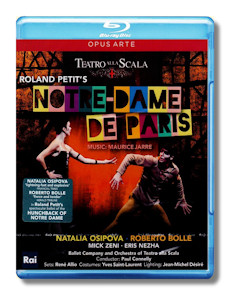
The Internet's Premier Classical Music Source
Related Links
- Latest Reviews
- More Reviews
-
By Composer
-
Collections
DVD & Blu-ray
Books
Concert Reviews
Articles/Interviews
Software
Audio
Search Amazon
Recommended Links
Site News
 Blu-ray Review
Blu-ray Review
Maurice Jarre

Notre-Dame de Paris
- Esmeralda - Natalia Osipova
- Quasimodo - Roberto Bolle
- Frollo - Mick Zeni
- Phoebus - Eris Nezha
Ballet Company & Orchestra of Teatro alla Scala/Paul Connelly
Choreography and libretto: Roland Petit
Recorded live at La Scala, February 2013
Opus Arte Blu-ray OABD7146D LPCM Stereo DTS-HD Master Audio 95m+15m
Also available on DVD OA1139D: Amazon - UK - Germany - Canada - France - Japan - ArkivMusic - JPC
A cabaret-style ballet may not exactly be the first thing that comes to mind when considering Victor Hugo's famous Romantic novel The Hunchback of Notre Dame, but as this is coming from Roland Petit (1924-2011), high priest of French choreography who obviously could do no wrong, very few will question the necessity to keep it in the running. Last year, the ballet troupe of Milan's Teatro alla Scala revived Petit's 1965 creation Notre-Dame de Paris with a stellar leading duo and a seriousness of purpose that would have done the late French master proud. The performance released on home video by Opus Arte is one of La Scala's live HD cinema screenings.
While Hugo's Notre Dame had already been successfully brought to the stage in the 19th century with the classical ballet Esmeralda, Petit's sixties facelift reduces the story to a cartoonish ménage à quatre. The simplified action, the gestural language and heavy brush choreography set to a darkish, percussion driven score from Maurice Jarre (1924-2009; better known from soundtracks like Lawrence of Arabia and Doctor Zhivago), the Yves Saint-Laurent costumes, have all aged rather badly. Yet, to most ballet lovers the main attraction of this release will be the presence of two of today's most beloved international stars, Russian guest ballerina Natalia Osipova as the gypsy girl Esmeralda and Italy's most adulated dancer Roberto Bolle as the hunchback bell-ringer Quasimodo. Very little what artists of their stature tackle is without interest and to have both of them cast against type turns it into an even more rewarding reading. Mick Zeni makes the most of the cardboard archdeacon Frollo, lusting for Esmeralda.
In its high definition, widescreen presentation Notre-Dame de Paris is a true feast for the senses. The flashy colors of Yves Saint-Laurent's costumes (read: medieval Paris in sixties chic), the dramatically lit sets from René Allio, including schematic outlines of what's supposed to be the Notre-Dame cathedral, are rendered with striking immediacy. The filming is overall well balanced and director Patrizia Carmine includes some spectacularly vertiginous overhead shots of the stage showing the corps patterns, but unfortunately also giving away Esmeralda's entrance too soon – otherwise one of the ballet's most theatrical moments. The darker scenes – and there are quite a few in this ballet, where the sun never seems to rise – challenge even the Blu-ray (especially when the all black Frollo moves against a pitch dark background), but generally this is a very satisfying release.
Sound-wise the Blu-ray is top-drawer as well, with Maurice Jarre's score punchily rendered by the DTS-HD Master Audio 5.0 mix – detailed, well balanced and dynamic – while the surround offers those adequately equipped an excellent live theatre ambiance.
Some 15 minutes of extras include interviews with Bolle and Osipova, talking about the challenges of their roles, as well as Luigi Bonino who staged the production for La Scala, mixed with shots from the rehearsal studio and the costume department. A lot more substantial bonuses could have been added, like documentaries about Roland Petit or the performance history of the ballet which began at the Paris Opera in 1965. The potential of the Blu-ray disc offering tons of space remains in this respect underused, but these brave attempts are steps in the right direction of how to present theatre performances on home video.
Copyright © 2014, Marc Haegeman




















